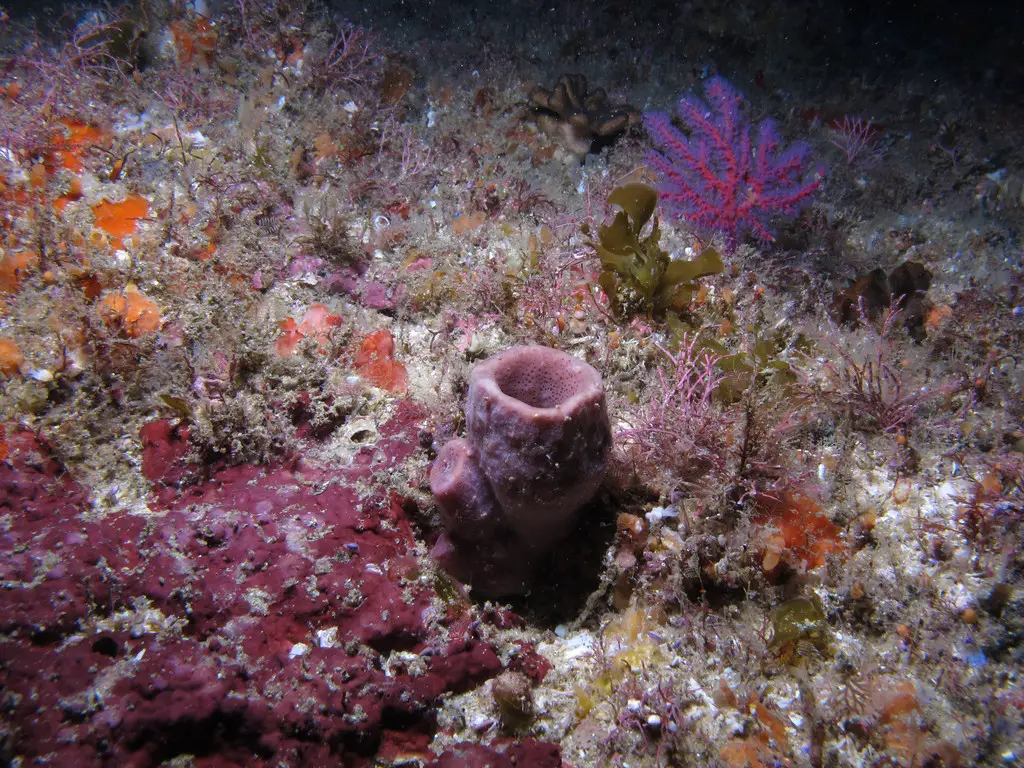Sponges are resilient invertebrates that have to be added to reef tanks in order to establish a colony. However, it only takes the smallest particle of a sponge to grow into a full-sized organism. They can reproduce quickly, and it won’t take long for a small group of cells to become a colony in competition with the other organisms in your reef tank.
Sponge particles can be accidentally introduced to reef tanks if they are clinging to coral or rocks which are added to a reef tank. Sometimes ornamental fixtures have not been thoroughly cleaned after coming in contact with sponges, and the smallest of sponge cells can allow for the growth of an entirely new colony.
Sponges will persist in a reef tank unless removed because they generally eat the same food as corals. So when you’re feeding your corals, you are also feeding the sponges. Sometimes sponges even outcompete corals for resources, so they may stick around while your coral dies off. Always thoroughly inspect any new rocks or corals before adding them to your tank.
How Do I Get Rid of the White Sponge in My Reef Tank?
White sponges can be difficult to remove, and some methods are more effective than others. One of the best ways to get rid of white sponges is to inject the organism with a diluted hydrogen peroxide solution or boiling water. This will kill the sponge without affecting the other organisms in your reef tank. Other effective methods include introducing predators that will eat the sponge.
Exposing the sponge to air will effectively kill it, as sponges are marine creatures that only thrive in aquatic environments. There are other ways to get rid of the white sponge, although these may harm the other organisms in your reef tank. Turning down the water flow and withholding food will effectively starve the sponge, but it may have the same effect on your coral.
Likewise, turning up the brightness on your aquarium lights will encourage algae growth which will choke out the sponge, but it may kill your coral too. These alternatives should only be considered if the hydrogen peroxide treatment or predator introduction does not work. Do not try scraping the sponges off manually, as a single missed cell could spawn a whole new colony.
How Do You Remove a Coral Sponge?
In a worst-case scenario, sponges can attach themselves to coral and begin to choke them out. In order to remove the sponge from the coral, you must be very careful, as the coral is delicate and easily damaged. One method to try is exposing the organism to air. While neither thrive outside aquatic conditions, the coral may be able to survive while the sponge dies off from exposure.
Another way to remove the coral is to isolate it in a bowl filled with just enough tank water to cover it. Then you should carefully and meticulously clean the sponge off the coral manually using instruments like a soft bristled toothbrush and some tweezers. Be sure to extract every small particle of sponge, or it will just grow back. Take care not to damage the coral’s sensitive tissue.
The most important thing to remember once you believe you have removed all the sponge particles from the coral is to rinse the coral with fresh tank water in another bowl. This way, all the contaminated water filled with sponge pieces does not get put back into the reef tank to infect the coral all over again.
Can Sponges Kill Coral?
Although not directly predatory to coral, sponges can kill coral in a number of ways. Coral and sponges compete for the same resources and due to rapid growth abilities, sponges will often win. Both coral and sponges are filter feeders that eat plankton and some particles floating in the water. If the sponges consume more than their fair share, they can inadvertently starve the coral.
Some sponges can attach themselves to coral and weave their way into the coral’s skeleton. This not only makes the sponges more effective competitors for resources, but can also physically kill the coral by clogging up the soft tissue. Sponges grow fast, so infection can happen before coral can put up a defense. Their ability for rapid expansion and nondiscrimination about new territory make sponges a danger to coral.
The most direct way that a sponge can kill a coral is by releasing toxins into the water that stress the coral into releasing its symbiotic algae and bleaching it. This method of warfare helps give sponges the edge over coral when obtaining resources such as food and space. Most aquarium sponges won’t have these toxins, but some that like to hide in the corners of aquaria may, so beware.
What Will Eat Sponges in Reef Tanks?
Sponges have a few natural predators, both vertebrates and invertebrates. There are a few species of angelfish that feed on sponges, which are small enough for reef tanks. They have specialized teeth hardened to eat the spike-like structures of the sponge’s cells, which protect it from other potential predators. They do not eat coral, so these fish are safe enough to keep for the purposes of sponge extraction.
Other animals which prey on sponges include nudibranchs, sea stars, pencil urchins, some species of snails, and crabs. There are a lot of invertebrate options for sponge removal. However, be sure to choose animals that solely feed on sponges, as some sponge predators also eat coral. These would not be well suited for your tank, since they will opportunistically feed on whatever is available.
Starfish and pencil urchins are a safer bet for invertebrate sponge removal if the sponge is more prominent than the coral. Crabs may be a bit more damaging to both coral and sponge and aren’t as efficient as the urchins or starfish. Always remove the invertebrates after the sponge has been completely consumed, so they do not eat the coral as well.


